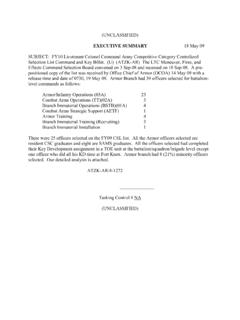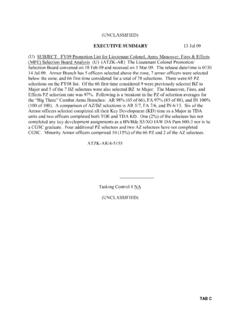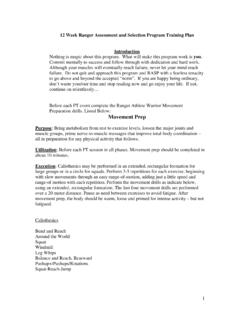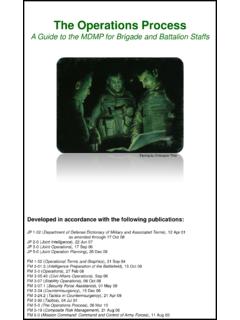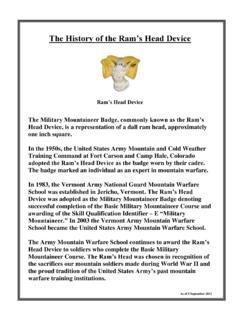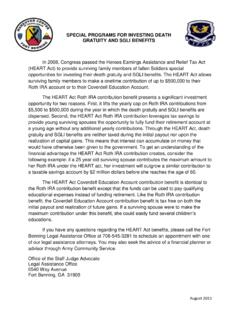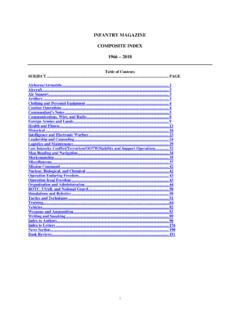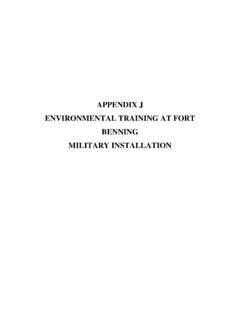Transcription of FM 3-90 V1, 12 December 2012 - United States Army
1 fm 3 -90-1 OFFENSE AND DEFENSE VOLUME 1 MARCH 2013 DISTRIBUTION RESTRICTION:Approved for public release; distribution is , DEPARTMENT OF THE army This publication is available at army Knowledge Online ( ). To receive publishing updates, please subscribe at fm 3 -90-1, C1 Change No. 1 Headquarters Department of the army Washington, DC, 14 June 2013 Offense and Defense Volume I 1. Change 1 to fm 3 -90-1, 22 March 2013, amends the definition for destroy. 2. A plus sign (+) marks new material. 3. fm 3 -90-1, 22 March 2013, is changed as follows: Remove Old Pages Insert New Pages pages B-11 through B-12 pages B-11 through B-12 pages Glossary-7 through Glossary-8 pages Glossary-7 through Glossary-8 4.
2 File this transmittal sheet in front of the publication for reference purposes. DISTRUBUTION RESTRICTION: Approved for public release; distribution is unlimited. PIN: 103287-001 fm 3 -90-1, C1 14 June 2013 By order of the Secretary of the army : RAYMOND T ODIERNO General, United States army Chief of Staff Official: GERALD B. O KEEFE Acting Administrative Assistant to the Secretary of the army 1310001 DISTRIBUTION: Active army , army National Guard, and United States army Reserve: To be distributed in accordance with the initial distribution number (IDN) 115848, requirements for fm 3 -90-1. * fm 3 -90-1 Distribution Restriction: Approved for public release; distribution is unlimited.
3 *This publication supersedes fm 3 -90, dated 4 July 2001. i Field Manual No. 3-90 Volume 1 Headquarters Department of the army Washington, DC, 22 March 2013 Offense and Defense Volume 1 Contents Page viii INTRODUCTION .. ix PART ONE OFFENSIVE TASKS Chapter 1 BASICS OF THE OFFENSE .. 1-1 Characteristics of Offensive Tasks .. 1-1 Offensive Tasks .. 1-1 Common Offensive Control Measures .. 1-2 Forms of Maneuver .. 1-2 Common Offensive Planning Considerations .. 1-22 Transition .. 1-42 Chapter 2 MOVEMENT TO CONTACT .. 2-1 General Considerations for a Movement to Contact.
4 2-1 Organization of Forces for a Movement to Contact .. 2-2 Control Measures for a Movement to Contact .. 2-4 Planning a Movement to Contact .. 2-5 Preparing for a Movement to Contact .. 2-7 Executing a Movement to Contact .. 2-7 Search and Attack .. 2-12 Cordon and Search .. 2-15 Chapter 3 ATTACK .. 3-1 General Considerations for an Attack .. 3-1 Organization of Forces for an Attack .. 3-1 Control Measures For an Attack .. 3-3 Planning an Attack .. 3-4 Preparing for an Attack .. 3-9 Contents ii fm 3 -90-1 22 March 2013 Executing an Attack .. 3-12 Special Purpose Attacks .. 3-23 Chapter 4 EXPLOITATION .. 4-1 General Considerations of an Exploitation .. 4-1 Organization of Forces for an Exploitation.
5 4-2 Control Measures for an Exploitation .. 4-4 Planning an Exploitation .. 4-5 Executing an Exploitation .. 4-9 Chapter 5 PURSUIT .. 5-1 General Considerations for a Pursuit .. 5-1 Organization of Forces for a Pursuit .. 5-2 Control Measures for a Pursuit .. 5-4 Planning a Pursuit .. 5-5 Executing a Pursuit .. 5-6 Pursuit During Other Than Major Combat Operations .. 5-9 PART TWO DEFENSIVE TASKS Chapter 6 BASICS OF THE DEFENSE .. 6-1 General Considerations of the Defense .. 6-1 Characteristics of the Defense .. 6-1 Defensive Tasks .. 6-2 Common Defensive Control Measures .. 6-3 Common Defensive Planning Considerations .. 6-3 Forms of the Defense .. 6-21 Transitions .. 6-29 Chapter 7 THE AREA DEFENSE.
6 7-1 General Considerations for an Area Defense .. 7-1 Organization of Forces for an Area Defense .. 7-1 Control Measures for an Area Defense .. 7-4 Planning an Area Defense .. 7-5 Preparing an Area Defense .. 7-10 Executing an Area Defense .. 7-12 Chapter 8 MOBILE DEFENSE .. 8-1 General Considerations for a Mobile Defense .. 8-1 Organization of Forces for a Mobile Defense .. 8-2 Control Measures For a Mobile Defense .. 8-3 Planning a Mobile Defense .. 8-4 Preparing a Mobile Defense .. 8-5 Executing a Mobile Defense .. 8-6 Chapter 9 THE RETROGRADE .. 9-1 General Considerations for the Retrograde .. 9-1 Delay .. 9-1 Withdrawal .. 9-12 Retirement .. 9-16 Unique Retrograde Situations.
7 9-19 Contents 22 March 2013 fm 3 -90-1 iii Appendix A BASIC TACTICAL CONTROL MEASURES .. A-1 Common Control Measures .. A-1 Appendix B TACTICAL MISSION TASKS .. B-1 GLOSSARY .. Glossary-1 REFERENCES .. References-1 INDEX .. Index-1 Figures Figure 1-1. Single 1-4 Figure 1-2. Double envelopment .. 1-4 Figure 1-3. Example envelopment control measures .. 1-5 Figure 1-4. Turning movement: turning force conducting the decisive operation .. 1-7 Figure 1-5. Control measures for a turning movement.
8 1-8 Figure 1-6. Infiltration lane .. 1-11 Figure 1-7. Linkup point 8 .. 1-12 Figure 1-8. Penetration: relative combat power .. 1-15 Figure 1-9. Penetration: minimum graphic control measures .. 1-16 Figure 1-10. The penetration .. 1-18 Figure 1-11. Widening the breach to secure the flanks .. 1-19 Figure 1-12. Seizing the objective .. 1-20 Figure 1-13. Frontal attack .. 1-20 Figure 1-14. Flank attack .. 1-22 Figure 1-15. Armored brigade combat team in battalion column .. 1-26 Figure 1-16. Line formation .. 1-27 Figure 1-17. Armored brigade combat team in echelon left formation .. 1-27 Figure 1-18. Armored brigade combat team in echelon right formation .. 1-28 Figure 1-19. Box formation.
9 1-28 Figure 1-20. Diamond formation .. 1-28 Figure 1-21. Wedge formation .. 1-29 Figure 1-22. Armored brigade combat team in vee formation .. 1-30 Figure 2-1. Force organized for a movement to contact .. 2-2 Figure 2-2. Movement to contact control measures .. 2-5 Figure 2-3. A column advance guard attacking to destroy a contained enemy force .. 2-7 Figure 2-4. Search and attack control measures .. 2-13 Figure 2-5. Company search and attack .. 2-14 Figure 3-1. Minimum attack control measures .. 3-3 Figure 3-2. Movement from the assembly area to the line of departure .. 3-11 Figure 3-3. Probable line of deployment and assault positions .. 3-17 Figure 3-4. Attack of an objective: the breach.
10 3-19 Figure 3-5. Attack of an objective: the assault .. 3-19 Contents iv fm 3 -90-1 22 March 2013 Figure 3-6. Ambush tactical mission graphic .. 3-23 Figure 3-7. Linear ambush .. 3-25 Figure 3-8. L-shaped ambush .. 3-25 Figure 3-9. Area ambush .. 3-25 Figure 3-10. Projected major counterattacks .. 3-27 Figure 3-11. Five phases of a raid .. 3-30 Figure 3-12. Spoiling attack .. 3-31 Figure 4-1. Control measures for a major exploitation .. 4-4 Figure 4-2. Control measures for a local exploitation .. 4-5 Figure 4-3. Brigade exploitation: battalions in column formation .. 4-6 Figure 4-4. Division exploitation: brigades abreast, no reserve .. 4-7 Figure 4-5. Brigade exploitation: two battalions forward, one in reserve.
